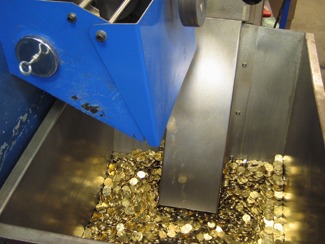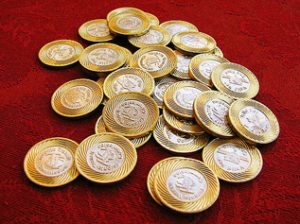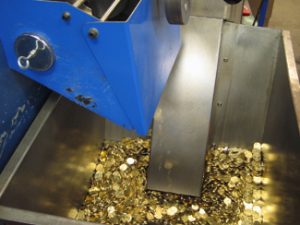
Steeped in history, America’s oldest private mint furnishes tokens for transit use
By Richard Tackett
Osborne Coinage Co., founded in 1835 as the Z. Bisbee Co., is America’s oldest private mint. Aside from tokens for use in transit and other transportation systems, Osborne mints custom made coins, casino tokens, amusements tokens and custom promotional key tags. David Blumenfeld, Osborne’s director of business and product development, says that around 45 transit agencies are buying tokens from the company despite the recent economic downturn.

“Our sales are up over 20 percent over the previous 12 months,” Blumenfeld says. “We’re seeing this in a lot of different markets and we attribute it mostly to the economy. Everyone’s expenses tightened up in 2010 and transit agencies were just making do. Tokens provide an advantage in that respect. It just means you have to open the fareboxes more often to count the tokens.”
Blumenfeld says that Osborne’s orders from transit agencies vary greatly. An agency with a small trolley system, for example, might only order 5,000 tokens. Other times, that same kind of agency will order 25,000 tokens with five different designs in hopes that riders will take them home as commemorative souvenirs. This is called “walkaway money” and it provides good publicity and a small profit center for the agency.
“Year ago I worked with the Metropolitan Atlanta Rapid Transit Authority when they were using tokens,” Blumenfeld says. “We did around 250,000 for the Peachtree Games and around 500,000 tokens for the 1996 Summer Olympic Games there. Even this year, Osborne’s had 250,000 and 500,000 token orders.”
Osborne fights the counterfeiters
Blumenfeld says that a number of anti-counterfeit measures are built into the token-making.
“As the value of fares and tokens has gone up, more people have tried counterfeiting them,” he says. “One thing we’ve begun making is called a bull’s eye token, which has a plug of a different kind of metal inside the token itself. The sophisticated manufacturing process makes it harder to counterfeit.”
After Osborne receives the required physical dimensions of a token from a transit agency, Blumenfeld says that most fareboxes can be reprogrammed easily to recognize the ordered token’s electromagnetic signature (EMS), another anti-counterfeit feature. Because each of the metals that Osborne uses is an alloy, there are different mixes of copper, nickel and other additives in each coin. Every alloy and diameter thickness has a slightly different EMS.
Osborne developed another method of counterfeit protection for the Toronto Transit Commission in 2006 called the X-mark. The agency had a counterfeiting problem with aluminum tokens at the time.
“The X-mark is an optical code that we emboss into the token, and there’s a company that sells retrofit coin mechanisms that are designed to look for these codes,” Blumenfeld says. “Toronto Transit may have ordered 40 million of these tokens from us.”
Token use shifts in the smartcard age
Blumenfeld says that there are many reasons why tokens became viable in the first place, and some still make sense today while others don’t.
“A big reason for tokens was so that agencies could easily adjust fares,” he says. “Back in the day, when a fare raised from 25 cents to 30 cents, it made sense to start selling tokens for a different value.”

Another advantage of using tokens, he says, becomes clear when handling cash fares. Tokens are a lot less attractive to steal than a bag of coins or other currency. Osborne provides tokens for many transit agencies, he says, for controlling cash flow and eliminating employee theft.
The process of switching to token payments, Blumenfeld says, is easier than switching to some of the newer fare collection systems.
“Changing from coins to tokens is not a big deal,” he says. “Transit agencies usually have all of the necessary equipment already installed. Their fareboxes need some modification and their counters need an adjustment, but it’s not a big change like going to an automated fare collection system or smartcard system.”
Ease of use aside, Blumenfeld says that more agencies are using tokens for exclusively commemorative uses.
“I think there will always be a demand for commemorative souvenirs,” he says. “But let’s face it: So many of our markets have new electronic systems coming in and they’ve got the budgets to use them.”
Looking to the future, Osborne Coinage has developed a new kind of business on the side: token destruction.
“We have a self-contained unit mounted on a semi-trailer that we send to various transit agencies,” Blumenfeld says. “We chop up all of their tokens and then we buy the scrap from them. It all gets recycled.” BR
